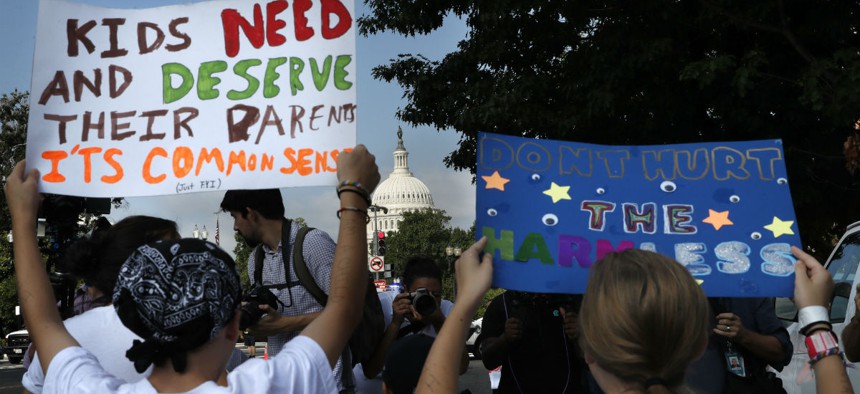
Protesters in July rally against the separation of children at the border. Jacquelyn Martin/AP
Watchdog: Government Separated 'Thousands' More Children at Border Than Reported
HHS inspector general says the exact number of children to enter the department’s custody as part of family separation policy is "unknown."
A Health and Human Services Department watchdog concluded that “thousands” more immigrant children were separated from a parent or guardian at the U.S.-Mexico border than the government had previously reported, and that the total number of family separations is “unknown.”
The HHS Office of Inspector General published a report Thursday finding that the current tally—2,737 children—applies only to children in the department’s custody as of a June 2018 federal court order requiring the data’s release. But the statistic does not include thousands of children who were separated from their parents and detained beginning in the summer of 2017 and released before the ruling was issued.
Ann Maxwell, assistant inspector general for evaluations at the HHS OIG, told reporters on a call to discuss the first of several reports on the department's implementation of the Trump administration’s child separation policy that HHS developed an ad hoc tracking system for “operational purposes” after the policy was implemented, and that the system was not conducive to “retrospective reporting.”
“HHS faced significant challenges identifying which children had been separated from a parent or guardian by [the Homeland Security Department], and there was no requirement for DHS to flag children as different from any other unaccompanied child,” Maxwell said. “There was no data system to track them across DHS and HHS.”
Maxwell said that the estimate of “thousands” of uncounted separated children comes from HHS staff, who based the conclusion on the fact that the proportion of separated children rose from 0.3 percent of all unaccompanied children placed in the custody of HHS’ Office of Refugee Resettlement in late 2016 to 3.6 percent in August 2017.
The inspector general did not directly tie the increase in family separations to an administration policy, but it noted in a timeline that Customs and Border Protection’s El Paso sector began implementing a family separation policy in July 2017, just three months after then-Attorney General Jeff Sessions issued a memorandum “prioritizing prosecution of immigration offenses.”
Likewise, Maxwell declined to comment on whether HHS officials were properly informed of the change in policy or advised of plans to begin separating children from their parents, saying the issue would be the subject of a separate report to be released “shortly in 2019.” She noted that the department’s “informal” efforts to track separated children stemmed in part from field interviews with children in its custody.
“What we do mention is that the informal tracking system started as an Excel spreadsheet started at the headquarters level by ORR intake staff,” she said. “Then later, that would be replaced by a Sharepoint database to gather information from the field after discovering some separations through intelligence that the care facilities were finding as they were interviewing children.”
Additionally, HHS officials reported that DHS reporting on separated children often was inadequate to reconnect them with a parent or sponsor.
“Incomplete or inaccurate information about the reason for separation, and a parent’s criminal history in particular, may impede ORR’s ability to determine the appropriate placement for a child,” the report stated. “[ORR] officials and staff noted that from a child welfare perspective, not all criminal history rises to a level that would preclude a child from being placed with his or her parent.”
In these situations, HHS officials often requested more information from the Homeland Security Department, but “the spreadsheet [the OIG] reviewed indicated that DHS did not always respond to these requests.”
Although DHS and HHS have developed a more formal system to track children separated from their parents at the border, Maxwell said “the jury’s still out” as to whether it will be effective.
“As of this point, there is a check box that DHS staff check to note that they have separated a child, there are fields in which more information can be provided, like including a parent’s name, their Alien Number, and other aspects that will allow the two departments to link the family back together,” she said. “[And] ORR has changed the case management system so that if they come across information [a child has been separated] even if DHS did not indicate [that], they can use the check box. So there is that redundancy built into the system.”
The inspector general's office described Thursday's report as the beginning of a "unprecedented" investigation of the child separation policy. Last year, it sent more than 200 staffers to 45 different HHS facilities as part of a massive two-week data collection effort.
Future reports will examine the department's efforts to reunify families, the screening and background checks of job candidates at facilities for separated children, the department's response to "incidents of harm," how children's medical and mental health needs are addressed, and facilities' security and emergency preparedness.







